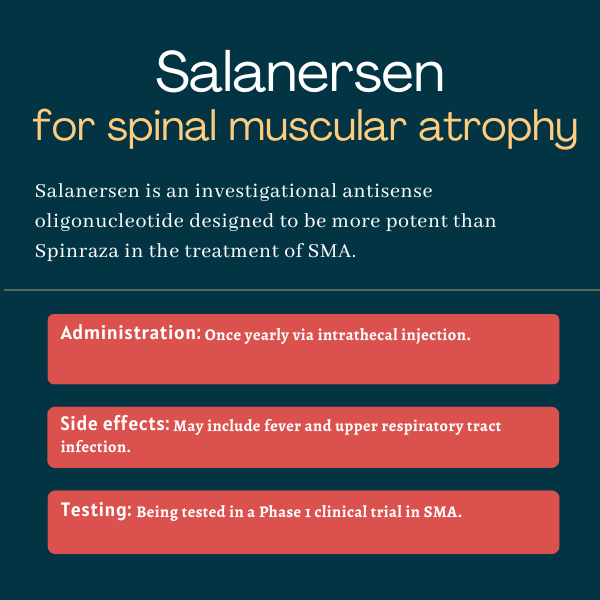Salanersen for spinal muscular atrophy
Last updated July 24, 2025, by Margarida Maia, PhD

What is salanersen for spinal muscular atrophy?
Salanersen is an investigational antisense oligonucleotide — a short strand of synthetic RNA or DNA molecules — for the treatment for spinal muscular atrophy (SMA).
The treatment is given by intrathecal injection — that is, directly into the spinal canal — and was designed to have enhanced potency, stability, durability, and efficacy compared with Spinraza (nusinersen), enabling dosing once a year. It is being developed by Biogen, which licensed it from Ionis Pharmaceuticals.
SMA is mainly caused by mutations in the SMN1 gene that result in a shortage of survival motor neuron (SMN), a protein that motor neurons need to survive and function. Motor neurons are the nerve cells that control voluntary movements. Without enough SMN protein, motor neurons gradually die off, resulting in progressive muscle weakness.
Like Spinraza, salanersen — previously known as ION306 or BIIB115 — binds to messenger RNA transcribed from SMN2. This is a backup gene that usually produces a shorter and less stable version of SMN. By binding to SMN2, salanersen is intended to increase the production of full-length, functional SMN protein.
Therapy snapshot
| Treatment name: | Salanersen |
| Administration: | Once-yearly intrathecal injection |
| Clinical testing: | In Phase 1 clinical testing for SMA |
How will salanersen be administered?
In clinical testing involving children with SMA, salanersen has been administered via intrathecal injection at a dose of 40 or 80 mg.

Salanersen in clinical trials
An ongoing Phase 1 clinical trial (NCT05575011) is testing how safe and well tolerated salanersen is when a single dose is administered directly into the spinal canal. It is also testing the pharmacokinetics of salanersen — how it moves into, through, and out of the body. The clinical trial has two parts.
- In the first part, volunteering healthy men were randomly assigned to receive single increasing doses of salanersen, or a placebo, and researchers are monitoring side effects for up to about one year.
- In the second part, 24 children with SMA who had previously received Zolgensma (onasemnogene abeparvovec) — an approved one-time gene therapy — were randomly assigned to receive salanersen at a dose of either 40 or 80 mg. Interim data showed a mean 70% reduction in neurofilament light chain (NfL) — a marker of nerve cell damage — at six months of treatment, which was sustained through one year. Among the eight children who received the 40 mg dose, four (50%) achieved motor milestones they previously could not achieve on their own, such as walking, crawling, standing, and sitting. They also experienced clinically meaningful improvements in motor function.
Salanersen side effects
Most side effects reported with salanersen were mild to moderate in severity and included:
- fever
- infection of the upper respiratory tract (nose, sinuses, and throat).
SMA News Today is strictly a news and information website about the disease. It does not provide medical advice, diagnosis, or treatment. This content is not intended to be a substitute for professional medical advice, diagnosis, or treatment. Always seek the advice of your physician or other qualified health provider with any questions you may have regarding a medical condition. Never disregard professional medical advice or delay in seeking it because of something you have read on this website.
Recent Posts
- Prostate cancer medicine may slow progression of SBMA: Real-world study
- Humor is my key to survival in life with SMA
- This Christmas, I’m thankful to have resolved some health complications
- No one knows what they’re doing and everyone is doing their best
- Itvisma approval ushers in era of therapeutic choice for SMA patients
